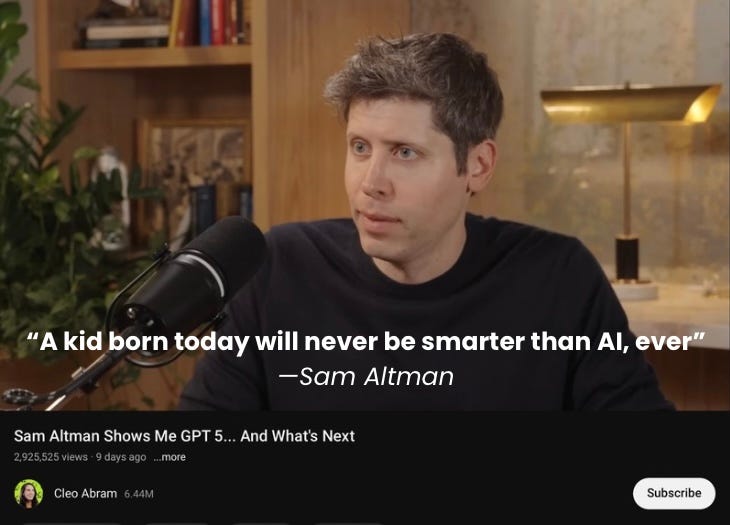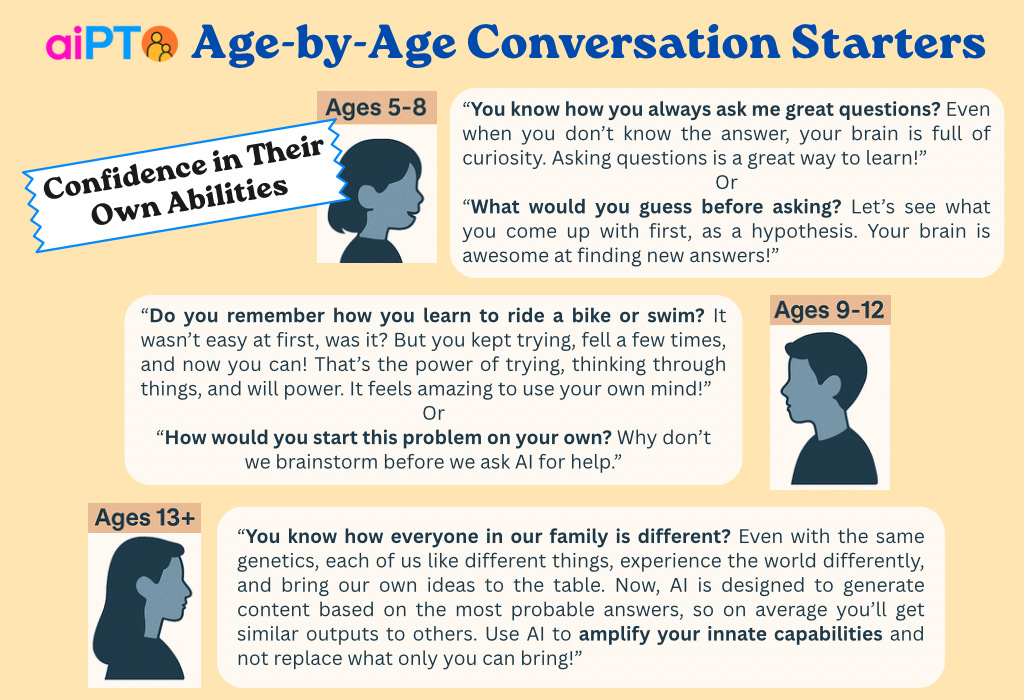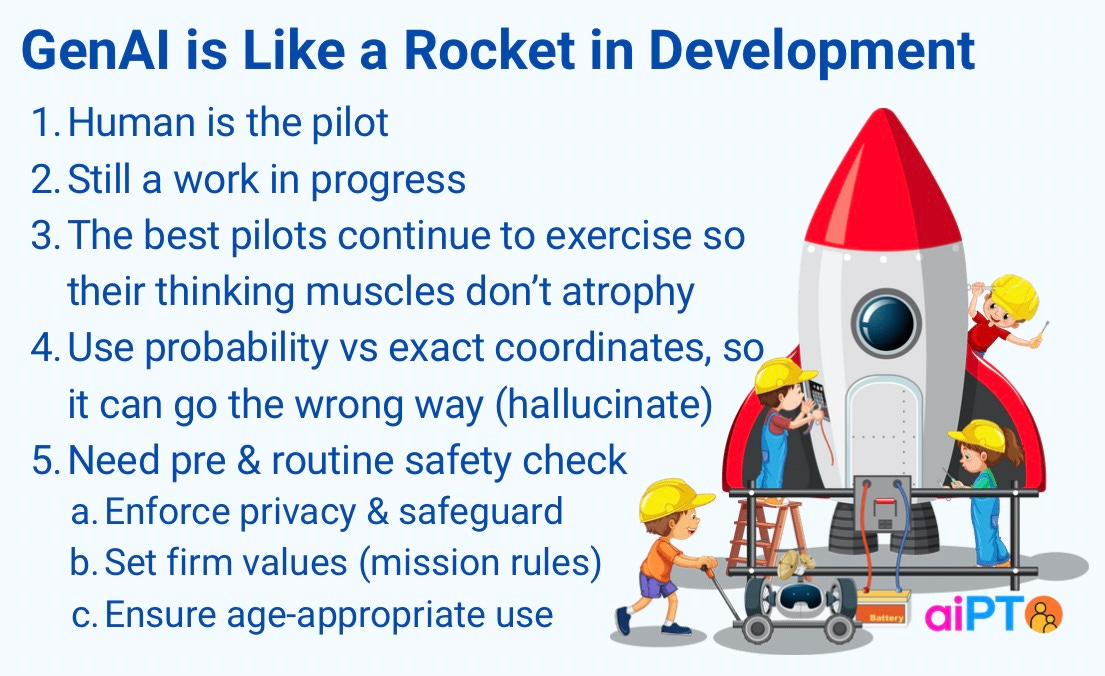3 Family Talks Your Kids Need Before Using AI
How parents can prepare kids for AI in school: building confidence, understanding, and values in daily conversations
Last week I delved into what parents need to expect in school with AI adoption, the factors that influence them, and specific questions all parents need to ask their schools.
Now I want to invite you to look inward, at the conversations we have at home.

Earlier this month, OpenAI’s CEO Sam Altman said “A kid born today will never be smarter than AI, ever,” in an interview with Cleo Abram.
As a parent, hearing that stings and I refuse to believe that. Even my first grader commented, “That’s not nice and true, right, Mommy?”
She’s right. That’s why we need to have these conversations now.
So, if we don’t guide our kids to live up to their potential in the AI era, guess what, someone else will.
There are plenty of AI-education content or “hacks” via TikTok or Youtube. Our teens use these social platforms in overwhelming numbers; 73% on YouTube and 57% on TikTok daily.1
So, let’s start these conversations at home, beginning with three that matter most.
1. Confidence and Belief in Their Own Capabilities
The belief that “humans are replaceable by AI” isn’t exactly empowering our kids to WANT to think for themselves.
When you believe that a machine will always outperform your efforts, would you even try using your own brain?
Secondly, the temptation to use AI without thinking is difficult even for most adults to manage.
That’s why we need to start with the belief and confidence in our own capabilities, early in childhood.
It will take more than a single conversation but it has to start with one.
There’s an urgency to this. Michael Gerlich’s 2025 research found a significant negative correlation between frequent AI tool usage and critical thinking abilities, mediated by cognitive offloading.2
Help them understand that thinking skills are like muscles. If you outsource your thinking to AI, your brain’s reasoning muscles stop getting exercise.
Here’s some conversation starters you can use based on your kids age group:
Age 5-8:
“You know how you always ask me great questions? Even when you don’t know the answer, your brain is full of curiosity. Asking great questions is a great way to learn!”
The Child Mind Institute recommended “metacognition”, the process of thinking about thinking, with young children to help them value their own creativity and not lean solely on outside tools.3
Try this whenever your child wants AI to answer a question: Pause and say, “What would you guess before asking? Let’s see what you come up with first, as a hypothesis. Your brain is awesome at finding new answers!”
Age 9-12:
“Do you remember how you learn to ride a bike or swim? It wasn’t easy at first, was it? But you kept trying, fell a few times, and now you can!
That’s the power of trying, thinking through things, and will power. It feels amazing to achieve something using your own mind!”
Stanford’s AI Lab suggests prompting “productive struggle” in pre-teens, meaning letting kids try before asking technology.4
So the next time your child wants AI to help solve their homework, encourage them to write down their own approach or guess first by asking, “How would you start this problem on your own? Why don’t we brainstorm before we ask AI for help.”
Age 13+:
“You know how everyone in our family is different? Even with the same genetics, each of us like different things, experience the world differently, and bring our own ideas to the table…
Now, AI is designed to generate content based on the most probable answers which means on average you’ll get similar outputs to others. Use AI to amplify your innate capabilities and not replace what only you can bring!”
Internet Matters recommended encouraging teens to reflect on their digital footprint and authenticity, using technology to support and not overwrite their voice.56
Help our kids understand that authentic thoughts and creations count. AI can be an amplifier or roadblock remover but we should NOT promote it to auto-pilot their thinking.

Following these conversations, the real work starts. The habits and encouragement of letting our kids actually practice thinking own their own.
2. Understanding AI Basics
AI powered ed-tech tools still have its limitations.
Not all AI powered tools are created equal. We need to help our kids understand the fundamentals of generative AI. What it can and can’t do.
What I’m describing below applies more to consumer generative AI tools. Be on the look out for my next and final back-to-school series, where I review prominent AI-powered ed-tech tools.
Consumer GenAI tools are designed to be helpful. They try to always answer everything you ask.
Together with its generative nature, the outputs lean toward what It predicts you want to hear vs what’s strictly accurate. Almost like a really smart autocomplete.
That may makes sense for business use. But for kids who are still learning to think critically, it can short-circuit the challenge kids need to learn.
If you’ve seen my writing, I love metaphors because it helps me easily explain AI concepts to my kids.
Here’s another way you can describe what AI is and is NOT at home.
GenAI is like a rocket in development. It has some quirks that our kids need to know.
Human as the pilot: We still need a human to define the destination and if we should use the rocket at all.
Rockets can really take you far but if you don’t know where you are going nor the physics of the ship, you’ll probably not go far or worse, doomed.
Sometimes we don’t even need a rocket. If you want to go to your neighbor down the road, would you walk or launch a rocket?
AI tools are another supporting vehicles that we need to discern when and how to use.
Work in progress: This rocket is actually still in development. It’s being built in public where users can test while engineers refine it.
This means AI outputs can still be unpredictable and require guidance. Take AI with a grain of salt because there are still plenty of unknowns.
I covered what researchers know and still figuring out about the impact of GenAI in a prior post.
Hallucinations: Last but not least, GenAI tools can provide inaccurate information often unintentionally due to hallucinations. Bad actors have also used AI to spread misinformation. Thus, we must double-check AI answers.
In fact, 39% of teens using AI for schoolwork have encountered inaccuracies, and 35% report being misled by fake AI content online (Common Sense Media, 2025).7
I explained this to my child as this rocket doesn’t use exact coordinates. It predicts the most likely destination based on patterns it’s trained on.
So it might confidently fly you to New York City when you asked for New York Avenue in your town because statistically, more people talk about New York the city. It’s just how this type of rocket is fundamentally built.
Let’s train our kids to build the skills to discern what and how they should leverage AI or any other technology.
3. Ethics and Safety in Using AI
Let’s build off our first and second conversations, where AI tool is the rocket and you’re the pilot.
Every pilot and astronaut checks critical systems before blasting off to ensure safety and performance.
Most GenAI tools are value-agnostic. This means it’s up to the user to discern the good vs bad use based on our family’s values and safety standards.
Pre-Launch Safety Check (for AI use):
Enforce strong safeguards on privacy, safety, and trusted apps.
Never load “personal cargo”, like private details, passwords or any secrets, into the rocket. Explain that sensitive info needs to stay at home.
I refer to common sense media ratings to double check safety and privacy ratings of a particular AI apps. Treat it like a pre-flight check.
Keep parental control on to ensure they stay safe.
Set firm value boundaries or “mission rules”:
A value that I apply at home and for myself is not using AI to cheat or cut corners.
Any rocket mission should serve a good purpose and not wasteful “fun”, or worse, damaging others, even through innocent pranks.
Ensure Age-Appropriate Usage:
My stance is elementary-age kids should not use GenAI chatbots.
If used at all, it needs to be guided by us, parents, or a trusted adult, like a teacher, and within a controlled environment where we can monitor their interactions with AI.
The focus should be on understanding what AI is and how it works.
Teens? Start with guided use and slowly increase freedom, while still using parental control. Follow the principles above:
Your teen starts with outlining their essay or guessing an approach without AI.
Then, learn together how to use AI as a reviewer, tutor, research partner or collaborator, when appropriate.
All the while, you are present to model spot-checking AI’s answers.
If you are interested in the full framework beyond the rocket metaphors, consider checking my THINK framework to build critical thinking skills when using AI.
Let’s Start Now
We can’t control what tech nor jobs will exist in ten years but we can raise kids who create authentically, think critically, and use tech wisely.
These three conversations (building their confidence, understanding the tech, and grounding our values) can build that foundation.
Try one of these conversations and make it yours. Then, let me know how it goes.
We’re all figuring this out together, one conversation at a time!
Dhani




I need to keep hope that our kids'(all of us) will be able to protect our beautiful human qualities in the age of AI takeover. Because this is what it is - a takeover of everything beautifully human about us - all of our dimensions. We have seen it already with smartphones. How we use it is not effective enough when we cannot control ourselves from using it all the time because we are dependent. The more we use AI the more our perception of what is authentic becomes blurred and distorted. AI becomes the standard. Perfection becomes the standard. And this will lead even the most resistant to succumb. This said, I appreciate these essays so much. They are essential. I believe that we who understand these risks must continue to stimulate free thinking, emotional intelligence, and the beauty of learning through personal experience. We must remember and remind that real emotions of curiosity, achievement, joy, love... cannot be felt unless created by us - imperfect humans connecting, learning, growing with other imperfect humans. AI cannot give us this ever. It is a taker, not a giver. Thanks again for continuino the conversations. 🙏❤️
You are providing excellent resources for parents. Keep up the great work Dhani!